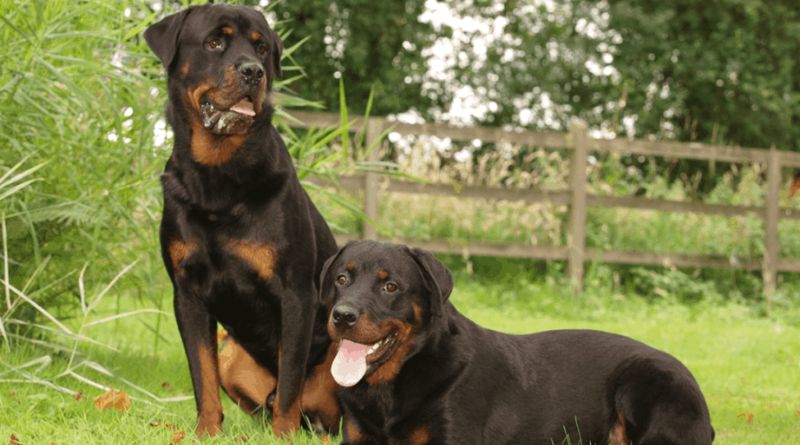Male Vs. Female Rottweiler – Rottweilers have garnered a reputation for their unwavering loyalty and robust strength, characteristics that contribute to their standing as one of the most beloved dog breeds. However, when faced with the decision of selecting a Rottweiler companion, the choice between a male and a female introduces a nuanced dimension to the decision-making process. Delving into these essential differences is crucial for prospective dog owners, as it allows for a more thorough understanding of the unique traits each gender brings to the table. This informed perspective becomes the compass guiding individuals towards a choice that harmonizes seamlessly with their specific lifestyle and personal preferences.
In essence, the decision to bring a Rottweiler into your life is a significant one, and recognizing the distinctions between male and female Rottweilers lays the foundation for a fulfilling companionship. Each gender comes with its own set of characteristics, temperamental nuances, and behavioral traits that contribute to the overall personality of the dog. By acknowledging and appreciating these differences, potential owners can tailor their choice to align with the dynamics of their household, ensuring a harmonious coexistence and a bond that stands the test of time.
Male Vs. Female Rottweiler: 10 Key Differences
Size and Build:

Male Rottweilers: These majestic canines typically boast a commanding physical presence, being larger and more muscular than their female counterparts. With a sturdy frame and well-defined musculature, male Rottweilers exude a robust and powerful aura.
Female Rottweilers: In contrast, female Rottweilers tend to exhibit a more modest size, embracing a leaner physique. While not as imposing in stature, their grace and agility are noteworthy, contributing to a sleek and streamlined appearance.
Also Read:- Different Types Of Mastiff Breeds
Physical Traits:
Male Rottweilers: Distinguished by their larger heads and necks, male Rottweilers carry a striking presence that emphasizes their overall robust build. These physical traits contribute to their formidable appearance, enhancing their role as potential protectors and guardians.
Female Rottweilers: Characterized by a more streamlined physique, female Rottweilers showcase elegance and grace. Their features, though not as massive, exude a distinctive charm, highlighting their femininity and agility.
Temperament:

Male Rottweilers: Known for their assertiveness and confidence, male Rottweilers often exhibit a self-assured temperament. These traits make them natural protectors, instilling a sense of security in their families.
Female Rottweilers: Females, on the other hand, may showcase a more nurturing side. Their temperament tends to lean towards affectionate and caring behaviors, making them excellent companions, especially in households with children.
Exercise Needs:
Male Rottweilers: With higher energy levels, male Rottweilers demand more vigorous activities and exercise routines. Regular and intense physical activities contribute to their overall well-being and help channel their energy positively.
Female Rottweilers: While still requiring regular exercise, female Rottweilers may have slightly lower energy levels. Tailoring their exercise regimen to their specific needs ensures they remain healthy and content.
Training Differences:
Male Rottweilers: Responding well to assertive commands, male Rottweilers thrive in an environment where training is firm and consistent. Their confidence benefits from clear and direct communication during training sessions.
Female Rottweilers: Responding favorably to a more patient and encouraging training style, females appreciate a nurturing approach. Positive reinforcement and understanding their unique learning pace contribute to successful training outcomes.
Health Considerations:

Male Rottweilers: While there are no specific health differences between genders, regular veterinary check-ups are crucial for maintaining the overall health and well-being of male Rottweilers.
Female Rottweilers: Unique health considerations arise due to heat cycles and reproductive health. Monitoring and addressing these aspects contribute to ensuring the long-term health of female Rottweilers.
Socialization:
Male Rottweilers: Displaying more territorial instincts, male Rottweilers may require focused socialization efforts to ensure they interact positively with other animals and people.
Female Rottweilers: Adaptable to various social situations, females generally exhibit a more versatile socialization pattern. Their approachability enhances their ability to navigate different environments comfortably.
Dominance Traits:
Male Rottweilers: Overt dominance may be more apparent in male Rottweilers. Their assertive nature may manifest in various situations, necessitating consistent guidance and training.
Female Rottweilers: Females may assert dominance in a subtler manner. Their approach is often characterized by a more nuanced display of authority, contributing to a balanced and harmonious environment.
Grooming:

Male Rottweilers: Male Rottweilers may shed more than their female counterparts, requiring regular grooming sessions to maintain coat health and minimize shedding.
Female Rottweilers: Both genders have short, dense coats that demand regular grooming. Consistent grooming not only enhances their appearance but also fosters a strong bond during the grooming process.
Adaptability:
Male Rottweilers: Thriving in larger spaces, male Rottweilers appreciate environments that accommodate their energy levels. Access to ample space contributes to their overall well-being.
Female Rottweilers: While adaptable to various living conditions, females particularly appreciate a comfortable and secure living environment. Providing a cozy and safe space ensures their contentment and happiness.
Also Read:- Things That Annoyed A Golden Retriever
Conclusion
Within the context of comparing male and female Rottweilers in the comprehensive guide titled “Male Vs. Female Rottweiler: 10 Key Differences,” delving into these subtle distinctions becomes a source of enrichment for anyone considering a Rottweiler as a companion. This exploration extends beyond mere information; it becomes a valuable tool for enhancing the overall experience of having a Rottweiler as a steadfast companion.
Whether your inclination leans towards the imposing strength inherent in male Rottweilers or the gentle, nurturing qualities exhibited by their female counterparts, both genders contribute to the spectrum of unique and fulfilling companionship. Recognizing and appreciating these nuances adds depth to the relationship, fostering a connection that goes beyond the surface traits of the breed. Each gender brings its own charm, quirks, and distinctive traits to the table, allowing for a personalized and rewarding bond with these magnificent dogs.
Frequently Asked Questions
Aggression is not solely dependent on gender; it’s influenced by training and socialization.
Both genders can make excellent family pets; it depends on individual temperament and training.







